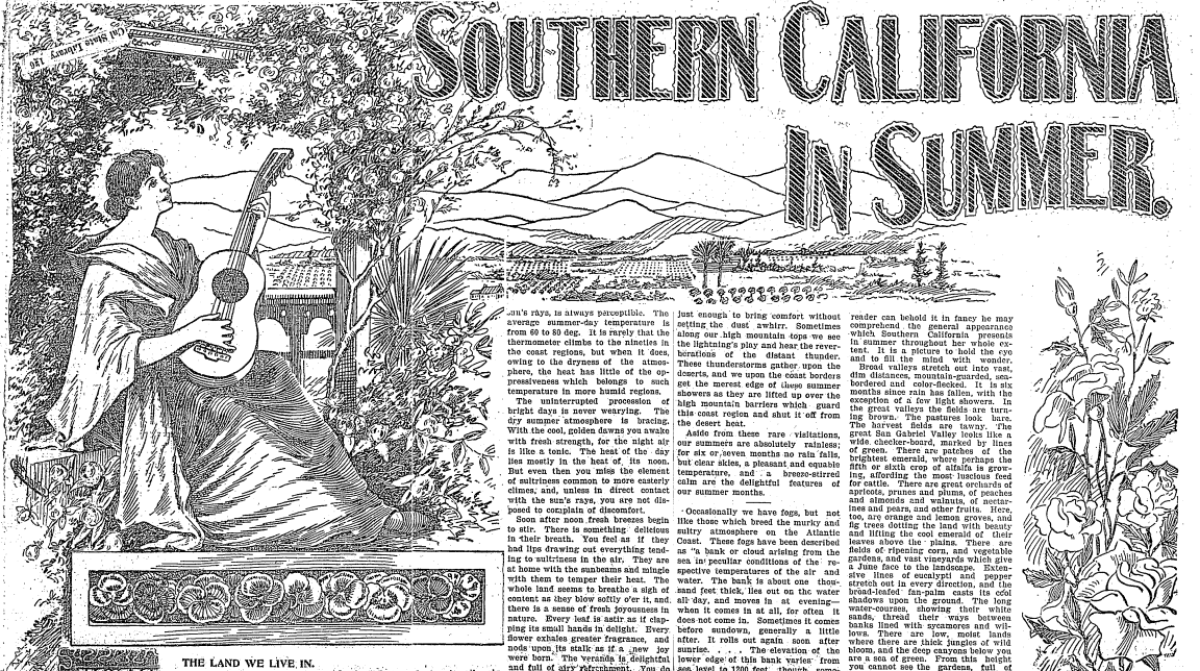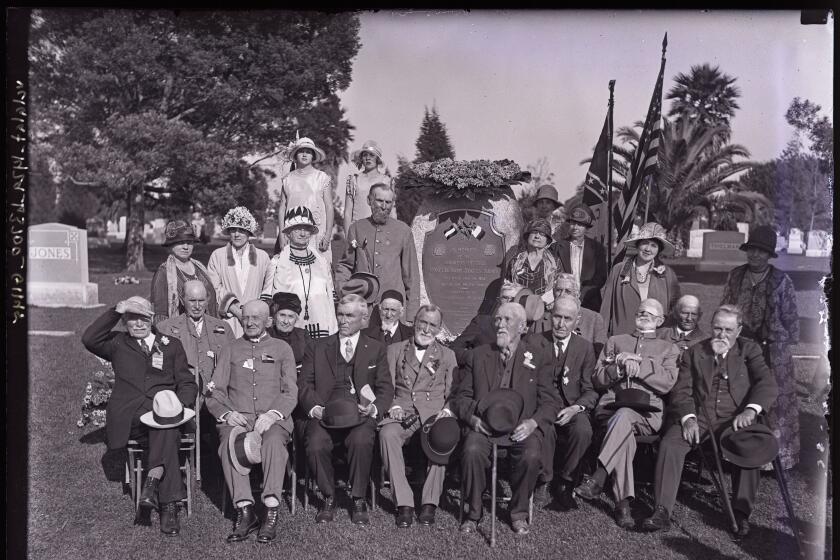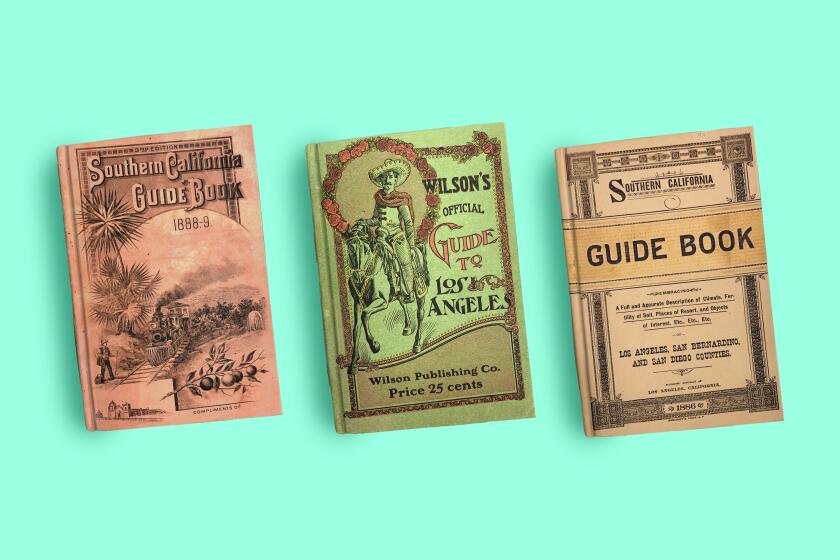Opinion: How Los Angeles ended up with the same nickname as the Confederacy

- Share via
If you’re curious about our country’s long history of polarization, look at the term “Southland.” Most Californians are unaware of exactly how the greater L.A. region wound up with a nickname more commonly associated with the Old South. The story behind this strange juxtaposition provides context for today’s crises, because it’s about America’s regional and political conflicts and how one opportunistic businessman profited from them.
The southeastern United States became widely known as the “Southland” beginning in 1861, when the Confederacy was formed. Before the first shots of the Civil War were ever fired at Fort Sumter, a poem titled “The Southland Fears no Foeman” was published in Richmond’s “Southern Literary Messenger.” From there, Confederate verse extolling “the Southland” flowed freely.
Unionists responded with their own verses. Augustine Duganne, a New York legislator, soldier and poet, asked in an 1863 poem: “For what hath all this Southland been / But one white sepulchre of sin / So fair without — so foul within?”
This week marks the anniversary of Robert E. Lee’s surrender near the end of the Civil War. Southern California, part of a free state from its beginning, held profound Confederate sentiment in the 1860s and beyond.
The Civil War ended in 1865, but the nickname and its association with the Confederacy endured. In 1878, a “Southland” poem recited at the Mississippi Press Assn.’s convention caused a firestorm. The author, Will Kernan, was a well-known extremist who wrote the deeply misanthropic “Song of Hate.” Although Kernan edited Mississippi’s Southern States newspaper, he was from Ohio, because then, as now, America’s polarization transcended regional boundaries. In “Southland,” Kernan attacked the 14th and 15th amendments, which respectively gave citizenship rights to Black Americans and voting rights to Black men: “Let the blessing of the ballot by Caucasians be controlled.”
Iowa’s Le Mars Sentinel pushed back with a parody of Kernan’s work: “Ho Southland / Sunny Southland /... Land of half-breeds, cross-breeds, bastards, hybrids, Hottentots, brigands, savages / Of raw-boned he-traitors and scrawny she-devils...” The Sentinel’s “Southland” was reprinted widely, enraging Southerners. In 1880, Mississippi’s Meridian Mercury called for an end to all cooperation with the North: “Above all, love your own sunny Southland...Eschew all slimy hypocrisy about loving the whole country.” The New York Times reprinted, and condemned, the Mercury’s diatribe.
As newspapermen nationwide wielded “Southland” in rhetorical brawls, Harrison Gray Otis, editor of the new Los Angeles Daily Times, started doing the same. California had its own north/south rivalry, and Otis resented Northern Californians’ snooty perception of the “cow counties” south of the Tehachapi Mountains. He used the Times to fight back, commissioning poems like Edward Vincent’s “Southern California”: “Time, place, opportunity, advantage are thine/ O fairest south-land.” Otis rebuffed San Francisco’s slights in the same way Lynyrd Skynyrd responded in “Sweet Home Alabama” to Neil Young’s anti-Southern insults: by “singin’ songs about the Southland.”
Otis wasn’t the first person to call L.A. the Southland, but he was the loudest, brandishing the word in his aggressive boosterism. In the boom/bust year of 1887, when the San Jose Mercury News encouraged central California to lure tourists away from the “crowded South,” Otis accused “the unhappy North” of “sectional jealousy,” deploring its plots against “this fair and sunny southland.”
The oldest “come hither” L.A. guidebooks in the Huntington Library archives are all about boosterism. What does the hype tell us about Los Angeles now?
Here, “southland” referenced geography. But one month later the Times accused “all Northern California” of conspiring against “Southland,” sending agents to “spy out the land and send the tenderfoot northward.” In this case, “Southland” represented a new region. As one Times writer explained: “We read much about the New South, referring to the Southern states of our Union. California has a New South, and the world at large is beginning to have a knowledge of it.” Increasingly, California’s New South embraced a connection to the old one.
On one hand this seemed appropriate, since early L.A. was full of Southern transplants who had supported the Confederacy. “Let it never be forgotten,” declared the San Francisco Bulletin in 1862, “that the county of Los Angeles, in this day of peril to the Republic, is two to one for Dixie and Disunion.” But Otis wasn’t Southern. He was a Union veteran from Ohio who’d fought at Antietam.
When Otis promoted California’s Southland, he wasn’t expressing the pride of a regional native — he was creating a new dominion. He had spent his glory days triumphing over the old Southland, and he replicated that triumph on the West Coast. “General Otis” borrowed from military vocabulary to call his L.A. mansion “the Bivouac” and his Times staff “the phalanx” as he built, and lorded over, a new Southland.
Unfortunately, Otis’ new dominion replicated the worst of the old: It grew into another white oligarchy where the rich got richer and the working class suffered. Otis made a fortune on real estate speculation while his rampant union-busting provoked the 1910 bombing of The Times in which 21 people died.
It would take another century for L.A. to build a better Southland. That work, in California and America, remains unfinished.
Laura Brodie is a professor of English at Washington and Lee University in Virginia. Her books include “Breaking Out: VMI and the Coming of Women.”
More to Read
A cure for the common opinion
Get thought-provoking perspectives with our weekly newsletter.
You may occasionally receive promotional content from the Los Angeles Times.












